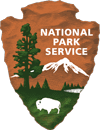
Niagara Falls State Park
Fredrick Law Olmsted helped protect, preserve, and design the nation's first state park and preeminent tourist attraction.
When landscape architect Frederick Law Olmsted first visited the American side of Niagara Falls in August 1869, he was shocked to discover that the scenic views of the waterfalls and surrounding natural landscape were obscured by mills, factories, and other vestiges of the Industrial Revolution. Goat Island was “the only piece of land spared brickworks and smokestacks.”
Olmsted soon joined the Free Niagara Movement, a small group of early environmentalists who “believed that the natural beauty of the land surrounding Niagara Falls should be protected from commercial exploitation and remain free to the public.” Back then, “an enterprising ‘entrepreneur’ need only buy a small parcel of land with a view, erect a tall fence and charge visitors from far and wide exorbitant fees to get a glimpse of the thunderous cataract.”
In early 1883, Olmsted helped found the Niagara Falls Association, a group of approximately 300 private citizens who put pressure on the NYS legislature to create a state-owned reservation around the Falls. Later that year, Governor Grover Cleveland signed a bill supporting the purchase of the land. In 1885, the Niagara Reservation was established, making it the first state park in the United States.
To remove the industrial blight, New York State used the power of eminent domain to acquire the privately-owned parcels and demolish all 150 structures on site. This marked the first time a state had used eminent domain for aesthetic purposes.
Olmsted and architect Calvert Vaux designed the reservation now known as Niagara Falls State Park. The two men had previously worked together as the primary designers of Central Park in New York City.
Completed in 1887, Olmsted and Vaux’s design consisted of “a park with scenic roadways, walking trails, and a minimal number of shelters. This, they believed, would protect the natural landscape and falls while also allowing large numbers of tourists to visit the site and experience the majesty of the Falls.”
Today, millions of people visit Niagara Falls State Park each year to see the stunning views of the three waterfalls that comprise Niagara Falls. The 400-acre park is replete with “lush terrain,” “beautiful gardens,” and hiking and biking trails. Popular attractions include the popular Maid of the Mist, Cave of the Winds, Niagara Adventure Theater, the Niagara Scenic Trolley, and the Discover Niagara Shuttle.
“Goat Island can be reached by car or by foot. There, a peaceful path through native vegetation reveals views of the Niagara River, another path leads to Three Sisters Islands and a walk to Terrapin Point features a breathtaking view of [the] Horseshoe Falls.”
Niagara Falls State Park is listed on the National Register of Historic Places and is also a National Historic Landmark.
Hope L. Russell, Ph.D.

